The powers not delegated to the United States by the Constitution, nor prohibited by it to the States, are reserved to the States respectively, or to the people.
—Tenth Amendment to the U.S. Constitution
The federal government’s continuous breach of constitutional constraintsREF is approaching a crisis point. Countless regulatory and statutory mandates are supplanting states’ governance over matters properly under their purview, including education, law enforcement, public health, infrastructure, insurance, land use, and even civil service.REF States have also become inordinately dependent on federal funding,REF which skews local priorities and imposes a multitude of burdensome obligations.REF
Imbalance in the federal–state relationship has profound effects on self-government. The U.S. Constitution unequivocally limits federal authority in order to impede the consolidation of power, as well as to maximize political accountability, policy innovation, and civic participation. To the extent that Washington violates constitutional strictures and usurps states’ authority, the functions of federalism are thwarted.
There is abundant evidence of excessive encroachment: The number and cost of federal mandates have increased markedly—an additional 457 enacted between 2006 and 2019REF—as have pre-emptionsREF of state and local authority. States are also more dependent on federal grants-in-aid, which comprised 32.4 percent of total state spending in fiscal year (FY) 2020.REF Outlays for the federal regulatory bureaucracy have grown by 18 percent in the past decade, to $66.2 billion in FY 2020REF—excluding budgets and staffing for tax functions, entitlement programs, and government procurement.
Federal dictates have likewise engulfed private enterprise, including 856 new mandates between 2006 and 2019.REF
Not only has federal power expanded in scope, it has also become increasingly coercive, including the effective takeover of public education, reams of health care dictates, and prohibitions on states’ appeals of federal property takings.REF The recently enacted COVID-19 “relief” act, titled the American Rescue Plan,REF prohibits states from enacting tax cuts as a condition of aid.
A number of other drastic measures are also in the pipeline. The Democrats’ H.R. 1 legislation, the so-called For the People Act, would override states’ election laws,REF while the House-passed Protecting the Right to Organize (PRO) Act would prohibit state right-to-work laws.
States periodically assert their sovereignty on select policy issues, as has occurred with immigration enforcement, physician-assisted suicide, same-sex marriage, and recreational use of marijuana.REF Most recently, 23 states announced their intention to opt out of federally funded enhanced unemployment benefits related to COVID-19,REF which appear to be a disincentive to work.REF
In some cases, states’ pushback is a matter of partisan politics rather than principle. In President Donald Trump’s first year, for example, Democratic states filed 35 lawsuits against the Administration (compared to 46 lawsuits filed by Republicans during the eight years of the Obama Administration).REF
Regardless of motivation, states’ legal victories these days are overwhelmed by the extent of the federal power grab, which stokes conflict and divisiveness by heightening the political stakes of even mundane matters.
Much of the Biden Administration’s agenda (in concert with congressional Democrats) will exacerbate the intergovernmental imbalance. President Joe Biden’s run of executive orders has dismantled a host of regulatory restraints, while his to-do list reflects the progressive conceit that government can remedy every economic hardship and cultural conflict, and all manner of human fallibility.REF
This Special Report assesses the accumulation of mandates, pre-emptions, and other types of federal arm-twisting. Its purpose is to establish a baseline for monitoring changes in the mandate burden, and to spotlight the erosion of federalism. Equally important, this report counters claims that federalism is an obsolete concept.REF
Previous efforts to curb intergovernmental meddling, such as enactment of the Unfunded Mandates Reform Act (UMRA), have largely failed, and systemic reforms are sorely needed. Both Democrats and Republicans have contributed to the problem, and reversing course will require action by both factions.
The Federalism Framework
The U.S. Constitution apportions specific, limited powers to the federal government, divided among the legislative, executive, and judicial branches. In contrast, states are granted considerable latitude.REF Federalist No. 45 articulates this federalism framework:
The powers delegated by the proposed Constitution to the federal government are few and defined. Those which are to remain in the State governments are numerous and indefinite. The former will be exercised principally on external objects, as war, peace, negotiation, and foreign commerce; with which last the power of taxation will, for the most part, be connected. The powers reserved to the several States will extend to all the objects which, in the ordinary course of affairs, concern the lives, liberties, and properties of the people, and the internal order, improvement, and prosperity of the State.REF
The powers granted to the federal government are enumerated in the Constitution’s Article I, Section 8 and include national defense, international trade and diplomacy, immigration procedures, maintenance of the monetary system, patent and copyright enforcement, and bankruptcy procedures.REF The Supremacy Clause and the Fourteenth Amendment also articulate aspects of federal authority over states.REF
The most explicit delineation of the parallel powers is the Tenth Amendment: “The powers not delegated to the United States by the Constitution, nor prohibited by it to the States, are reserved to the States respectively, or to the people.”
This division of authority is essential to safeguarding liberty by impeding the consolidation of government power. Dispersed power also allows states to tailor policies to distinct geographic, cultural, and political conditions that broad-stroke federal policies would overlook. Keeping elected officials and bureaucrats in plain sight—or closer, at least—heightens accountability, and citizens are more likely to participate in the democratic process when their impact is undiluted by political interlopers.
These attributes of federalism frustrate authoritarianism (and progressives, particularly) by multiplying the loci of power that must be captured for political movements to succeed.REF As pointed out by Rob Hunter, “progressive social movements are frequently distracted and bogged down by a morass of different political and institutional contexts across the fifty states.”REF
That explains, in part, current progressive efforts to dismantle federalism, including elimination of the Electoral College, scrapping the Senate filibuster, pre-empting state election laws, and relentlessly expanding the administrative state.REF
Federal Expansionism
Reflecting its enumerated powers, the executive branch was comprised of nine departments in the nation’s first 100 years.REF The 20th century, however, brought a massive expansion of the administrative state, including establishment of the Departments of Commerce, Labor,REF Health, Education and Welfare, Housing and Urban Development, Transportation, Energy, Education, Veteran’s Affairs, and Homeland Security.
This federal overreach has been abetted, to some degree, by some loose language in the Constitution—the Commerce Clause, in particular. Congressional authority “to regulate Commerce…among the several States” is routinely cited to justify infringements of state sovereignty, and jurists and scholars have debated for decades the contours of “interstate commerce.”
As noted by scholar Adam Thierer, “modern federal jurists and legislators, as well as many so-called progressive academics and legal theorists, have contorted the interpretation of [the Commerce Clause] to…justify an ever-expanding array of federal programs and regulatory interventions.”REF
Dramatic expansionsREF of federal power largely occurred during three distinct periods: (1) the Progressive Era, (2) the New Deal Era, and (3) the Great Society/Modern Era.
The Progressive Era. Massive industrialization and waves of immigration contributed to enormous wealth creation at the turn of the 20th century, but living conditions in major cities deteriorated. Reformers sought to remedy a variety of social ills through federal regulation of food, drugs, and labor. Trading on populist resentment toward industrialists, President Theodore Roosevelt also aggressively expanded antitrust enforcement.
The New Deal Era. The stock market crash of 1929 and the ensuing Great Depression prompted a profusion of public works projects and broad regulation of banks and securities. Congress approved 16 new federal grants to state and local governments between 1933 and 1938, and increased grant funding from $214 million in FY 1932 to $790 million in FY 1938.REF
New initiatives of the period included the Civilian Conservation Corps, the Farm Security Administration, the Social Security Act, the Federal Deposit Insurance Corporation, the National Labor Relations Board, the Securities and Exchange Commission, and the Tennessee Valley Authority.
The Great Society/Modern Era. A new wave of federal expansion rolled through the 1960s and 1970s, focused on civil rights, consumer protection, education, mental health services, and environmental conservation. President John F. Kennedy, in a 1962 speech, called on Congress to enact legislation to protect consumer rights.REF Three years later, Ralph NaderREF exposed the design flaws of the Chevrolet Corvair (and its rear engine), and alleged automaker resistance to installing safety features. Such activism inspired a regulatory tsunami, much of which endures despite dramatic changes in the economic, environmental, and social landscapes.
The era brought congressional enactment of more than 500 regulatory programs affecting state and local governments,REF including the:
- Civil Rights Act of 1964,
- Voting Rights Act of 1965,
- National Traffic and Motor Vehicle Safety Act of 1966,
- Age Discrimination in Employment Act of 1967,
- Consumer Credit Protection Act of 1968,
- National Environmental Policy Act of 1969,
- Occupational Safety and Health Act of 1970,
- Clean Air Act of 1970,
- Equal Employment Opportunity Act of 1972,
- Federal Environmental Pesticide Control Act of 1972,
- Consumer Product Safety Act of 1972,
- Endangered Species Act of 1973,
- Fair Labor Standards Act (Amendments) of 1974,
- Safe Drinking Water Act of 1974,
- Toxic Substances Control Act of 1976,
- Clean Water Act of 1977, and
- Public Utilities Regulatory Policy Act of 1978.
The federal focus on environmental and energy regulation occurred in spite of “great strides” by states to control air pollution problems.REF The regulatory frenzy also drove a massive increase in agency spending, from $218 million in 1960 to $5.2 billion in 1980 (in constant 2012 dollars).REF
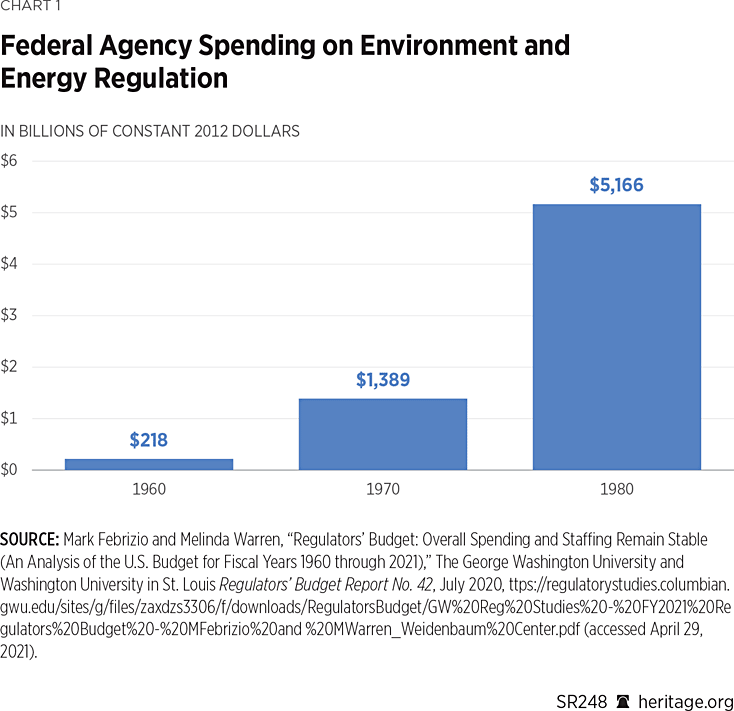
Each era of federal expansion swelled the bureaucracy:REF
- Between 1891 and 1920, executive branch employment increased by 376 percent (from 34,834 to 165,796).
- Between 1930 and 1945, executive branch employment increased by 292 percent (from 187,594 to 736,000).
- Between 1960 and 1980, executive branch employment increased by 57.8 percent, excluding an estimated 5 million contract employees (from 761,000 to 1,201,000).
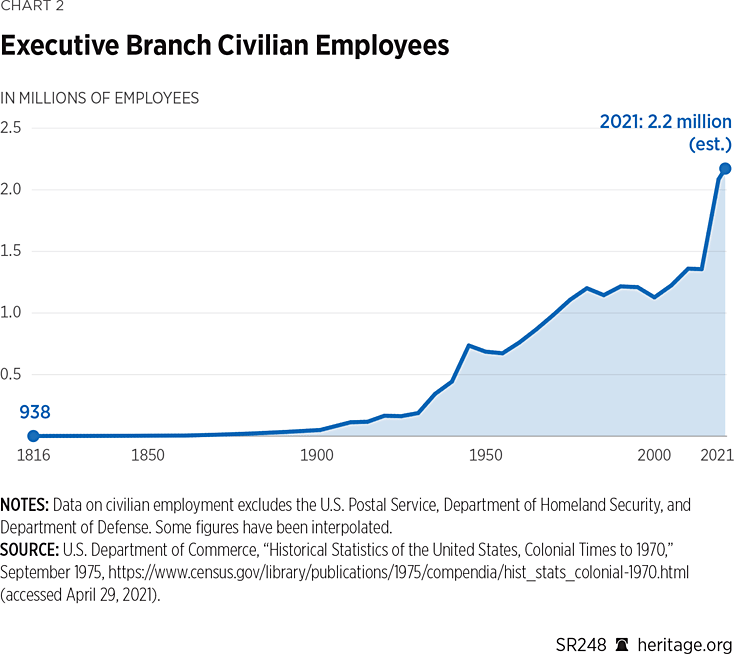
In theory, the regulatory expansion incorporated “cooperative federalism,” that is, power sharing between Washington, DC, and the states. The Clean Air Act, for example, directed the Environmental Protection Agency (EPA) to set ambient air quality standards for six “criteria” air pollutants,REF for which states would devise and implement emissions-reduction plans for approval by the agency.REF
Whether these and similar regulatory schemes constitute actual power “sharing” is debatable, since the federal government remains the arbiter of the standards and the enforcer of compliance. Allowing states to implement federal regulation is certainly preferable to federal administration—but only if states exercise a modicum of discretion. Otherwise, it is a costly paperwork exercise.
New Mexico’s former governor, Susana Martinez, testifying before a House Speaker’s Task Force on Intergovernmental Affairs, noted that her state could process oil and gas permits in 10 days, while it takes the federal Bureau of Land Management (BLM) 250 days. The delay, she said, produced a BLM backlog of more than 800 applications at a cost (in lost and delayed revenue) of $710 million for New Mexico and $1.2 billion for the federal government.REF
Forms of Power-Shifting
Federal intrusion in states’ affairs has taken a variety of forms, including mandates, funding obligations, pre-emptions, and regulation.REF
Federal Intergovernmental Mandates. The term “federal intergovernmental mandate” refers to a provision in statute or regulation, or federal court ruling that imposes an “enforceable duty” on state, local, or tribal governments (excluding a condition of federal assistance or a duty arising from participation in a voluntary federal program).REF
Growth in the number and scope of federal mandates is largely a modern phenomenon. Researchers have documented one instance of Congress enacting a major mandate in 1931, one in 1940, none in the 1950s, nine in the 1960s, 25 in the 1970s, and 27 in the 1980s.REF Since 2000, Congress and various Presidents have approved more than 190 statutesREF with intergovernmental mandates, according to the Congressional Budget Office (CBO). Collectively, the laws have imposed more than 1,000 separate directives.
Even that figure is artificially low because the definition of “mandate” applied by the CBO is exceedingly narrow. For example, many of the costly obligations linked to entitlements are not categorized as mandates because the funding is considered “voluntary.”
That rationale may have seemed plausible when federal support for Medicaid and other entitlements constituted a relatively small portion of state and local revenues, but that is certainly no longer the case.REF State reliance on federal funds has vastly increased. As noted by the U.S. Advisory Commission on Intergovernmental Relations, “Many grant conditions have become more integral to state and local activities—and far less subject to voluntary forbearance—than originally suggested by the contractual model.”REF
There is no official tracking of federal mandate costs, nor is there any accounting of the cumulative effects.REF States have been protesting the burden for more than two decades. During a 2007 summit, for example, legislators from 50 states boarded a schooner to re-enact the Boston Tea Party in opposition to an estimated $100 billion in unfunded mandates imposed over four fiscal years.REF
In some instances, Congress has appropriated funds to states to cover mandate costs, but state officials insist that most mandates are either inadequately funded or wholly unfunded. Then-Governor of Tennessee Bill Haslam (R), for example, informed the House Committee on Oversight and Government Reform that his state received only 8 percent of the $32 million it cost to implement programs under the Clean Water Act.REF
Even when states support federal policy goals, mandate overreach makes a mess of federalism. The centralization of federal power inhibits the policy innovation and local expertise that state autonomy provides.
There is no way that federal mandates can accommodate the multitude of conditions in a nation of 320 million people located across 3.8 million square miles of urban, rural, and frontier areas. As explained by New Mexico Governor Susana Martinez, “What works in South Carolina may not work in Virginia. And what works in New Mexico may not work even for our neighbors in Utah, which is precisely why it is imperative the federal government recognize the sovereignty of states.”REF
Testifying on behalf of the Council of State Governments, Utah Senate President Wayne Niederhauser told the House Committee on Oversight and Government Reform: “Goals behind federal mandates are often admirable, but we have our own local goals which are just as admirable, more important to local citizens, more likely to be effective and less expensive.”REF
For example, the Endangered Species Act authorizes the U.S. Fish and Wildlife Service to write management plans, designate critical habitat, and impose land-use restrictions. But former Utah Governor Gary R. Herbert (R) points out that “Utah’s Division of Wildlife Resources is staffed with some of the best biologists in the field who have a profound knowledge of Utah’s ecology and wildlife. There is no good reason states shouldn’t take the lead in species recovery.”REF
The concentration of policymaking in Washington also undermines opportunities for citizen involvement—which is the essence of self-government. Individual voters wield greater influence at the local level, where their preferences are far less diluted than at the federal level. As noted by Gregory Gleason and Viktor Rudenko, “Distant rule-making bureaucracies are immune from local pressure; Congress is overrun with powerful and well-heeled interest groups; and enormous coalitions of citizens are required to get even rudimentary attention from Washington.”REF
Grants-in-Aid. From 132 programs in 1960, to 387 in 1968, and 664 in 1998, the number of grant programs funded by federal dollars now totals a whopping 1,274.REF
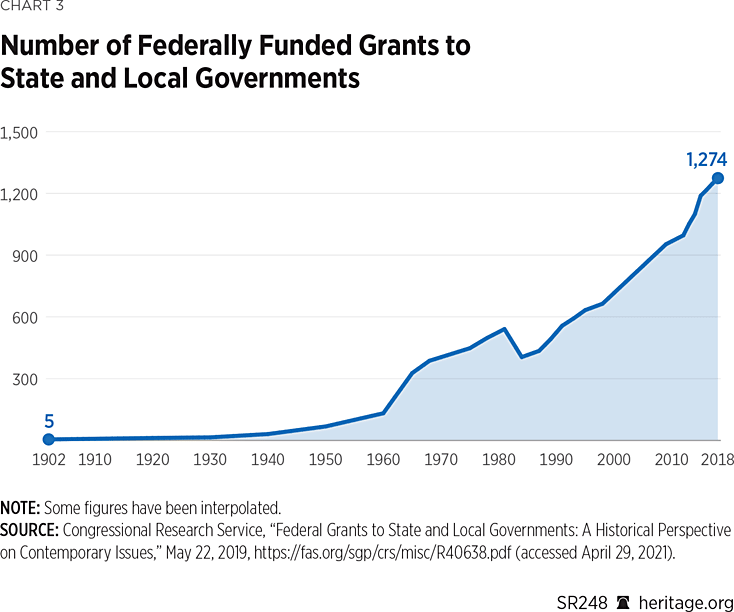
Grants-in-aid were relatively rare until the 1960s, when President Lyndon Johnson employed them for his War on Poverty. Medicaid, instituted in 1966, is the single largest federal grants-in-aid program.REF
The three types of federal grants—categorical grants, block grants, and general-revenue-sharing—vary in the degree of spending discretion.REF Virtually all require state expenditures or legislative action to fulfill the federal conditions of funding.
The various conditions attached to the grants are set by Congress in statute (unless lawmakers delegate the task to agency regulators), and inject federal involvement in virtually every type of public policy.
The volume of red tape is massive. To obtain or retain funding for social welfare programs, state and local governments must submit to 979 federal “information collections” (with an additional 95 pending). Other federal programs involve 351 mandatory information collections encompassing 1,328 forms (and 53 pending requests for an additional 169 forms).
In 2019, the federal government allotted $721 billion in aid to state and local governments for a wide range of programs, including health care, transportation, income security, education, job training, social services, community development, and environmental protection.REF Such spending has increased as a percentage of federal outlays from 10.7 percent in 1989 to 16.2 percent in 2019.REF
Even more troubling, federal grants-in-aid comprised 32.4 percent of total state spending in FY 2020 (an estimated $2.3 trillion), according to the National Association of State Budget Officers.REF
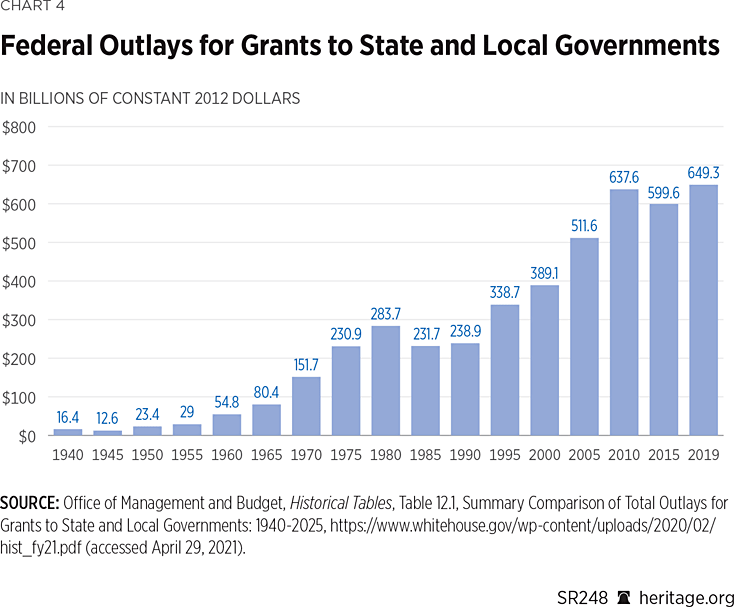
Federal grants-in-aid have steadily outpaced inflation. There have also been intermittent spikes, such as the $272.6 billion in grants, contracts, and loans (between FY 2009 and FY 2014) under the American Recovery and Reinvestment Act.REF Likewise, Congress has authorized a whopping $878 billion in COVID-19 relief for state and local governmentsREF—far exceeding the actual loss of revenue from the pandemic lockdown.
With very few exceptions, the U.S. Constitution does not permit Congress to force states to administer federal programs or to adopt federal policy.REF However, because federal grants are considered voluntary, Congress routinely sets grant conditions to drive policy at the state level.REF The U.S. Supreme Court has upheld the imposition of grant obligations to steer state policies under the Constitution’s (loosely worded) Spending Clause, which empowers Congress “to lay and collect Taxes…to…provide for the…general Welfare of the United States.”REF
However, the Supreme Court has also set parameters for determining whether mandates are excessive. For example, a statute is invalid if it exceeds the scope of the constitutional power under which Congress purports to be legislating, according to Patricia Northrop.REF A mandate will also be struck down, Northrop notes, if it directly instructs a state legislature to enact particular legislation. The Supreme Court has held that any conditions attached to the receipt of federal funds must:REF
- Be established unambiguously so that recipients can knowingly accept or reject them;
- Be germane to the federal interest in the particular national projects or programs to which the money is directed;
- Not violate other provisions of the Constitution, such as the First Amendment or the Due Process or Takings Clauses of the Fifth Amendment; and
- Not cross the line from enticement to impermissible coercion, such that states have no real choice but to accept the funding and enact or administer a federal regulatory program.
The imposition of at least some grant conditions is necessary for accountability. However, the scope of obligations has broadened well beyond administrative oversight, provoking “a rising chorus of complaints from state and local government officials.”REF
So-called crossover sanctions often provoke protests. For example, the Real ID Act set national standards for driver licensure—long the prerogative of states. But Congress threatened to prohibit airline travel for residents of states that failed to adopt the federal standards. Likewise, the Alcohol, Drug Abuse and Mental Health Administration Act required states to prohibit the sale of tobacco products to minors or risk the loss of federal funding earmarked for substance abuse and mental health.REF
The latest case of congressional bullying is meeting fierce resistance from GOP states. A coalition of 21 state attorneys general is questioning the constitutionality of a provision in the newly enacted COVID-19 relief measure that bars additional pandemic aid to states instituting tax cuts.REF In other words, the Democratic Congress is punishing states that are seeking to stimulate growth—a more sustainable means of economic recovery from the COVID-19 lockdown than lavishing hundreds of billions of dollars on profligate legislatures.
Also of particular note is the shift in the type of aid to states, as documented by John Kincaid.REF Whereas the majority of federal funds were once disbursed as block grants intended for state and local infrastructure and public services, the majority is now aid for individuals (such as Medicaid, the Children’s Health Insurance Program, Temporary Assistance for Needy Families, and unemployment benefits). Formula-based welfare programs largely prohibit states from exercising policy discretion.
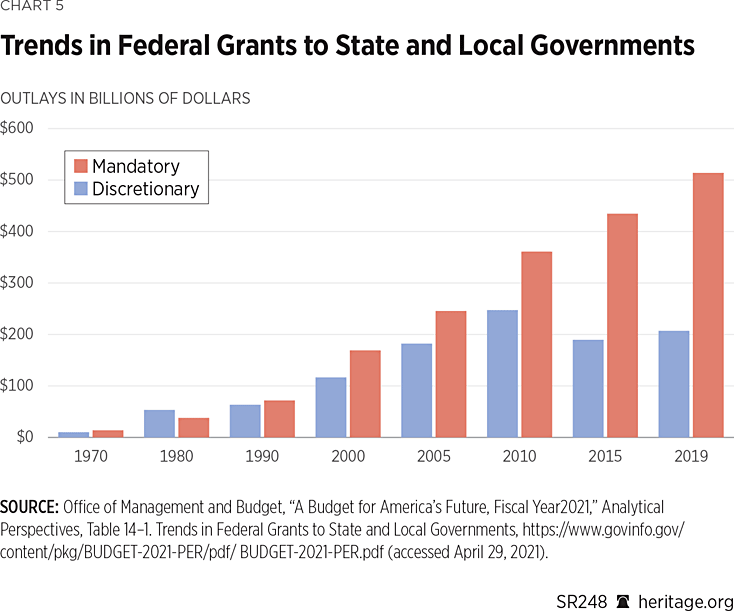
The shift in grant funding carries significant consequences for state budgets. Aid to individuals comprised 25.3 percent of federal outlays to state and local governments in 1978. That proportion nearly doubled—to 49 percent in 1988, and rose to 65.8 percent by 2008. Last year, aid to individuals was estimated to be 76.4 percent of grant-in-aid funding.REF
That shift has rendered states as agents of federal redistribution. In turn, “place-based” aid (infrastructure, criminal justice, economic development, environmental protection, and government administration) has declined from 74.7 percent of annual grant funding to 31.8 percent in the same period.
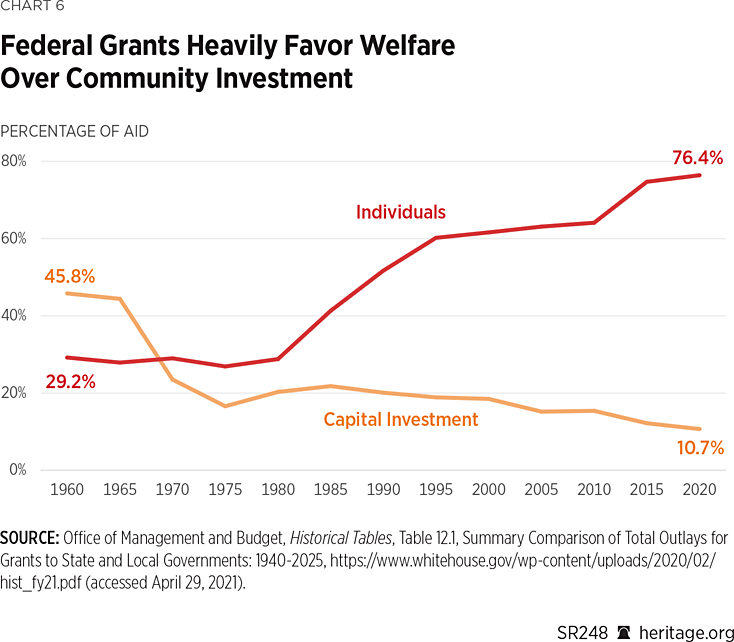
Notwithstanding lawmakers’ boasts about bringing home the bacon, grants-in-aid to state and local governments are not free. In fact, states with the most high-income earners receive less in federal grants than the amount of taxes residents send to Washington.REF Conversely, states with relatively high poverty rates receive considerably more federal grant dollars than residents pay in income taxes.
Pre-emption. The term “pre-emption” refers to the constitutional authority of Congress to subordinate state law,REF as embodied in the Supremacy Clause:
This Constitution, and the laws of the United States which shall be made in pursuance thereof; and all treaties made, or which shall be made, under the authority of the United States, shall be the supreme law of the land; and the judges in every state shall be bound thereby, anything in the Constitution or laws of any State to the contrary notwithstanding.
The pre-emption power is limited—at least in theory—to the scope of authority granted to Congress in the U.S. Constitution.REF In other words, federal law does not automatically trump state law simply by virtue of enactment by Congress.REF
Congress in recent decades has exercised pre-emption on a broad scale. Of the 520 statutory pre-emptions enacted between 1790 and 2004, two-thirds occurred after 1965.REF The U.S. Supreme Court has likewise condoned broad-ranging federal pre-emption authority despite constitutional limits. This has permitted the federal government to intercede in many policy areas delegated to the states.REF
Unlike a mandate, pre-emption does not require state or local governments to act. Instead, pre-emption most often precludes state or local action. Prohibiting action can impose considerable costs.REF For example, federal policies that pre-empt state and local authority to tax specific activities or entities carry major fiscal impacts, and effectively force states into a type of tax competition with the federal government.REF
Interstate businesses often lobby in favor of pre-emption to avoid a “patchwork” of state and local laws that complicate regulatory compliance. There are obvious and significant costs related to multiple regulatory regimes. As noted by John Kincaid, “Business…often prefers total preemption because it would rather risk regulation by one 500-pound gorilla in Washington, D.C., than fifty monkeys on steroids.”REF
However, excessive pre-emption inhibits policy competition among states, as well as the relative transparency and accountability of state-level and local-level regulation. It also impedes the ability of both citizens and businesses to escape flawed policies by crossing state borders.
Pre-emption is not the only means of securing regulatory uniformity. Alternatives include state compacts, self-regulation, federal–state performance partnerships, and uniform state laws.REF
Private-Sector Mandates
As with intergovernmental mandates, private-sector mandatesREF impose enforceable duties on individuals, partnerships, associations, corporations, and educational and nonprofit institutions. These mandates are imposed in a variety of forms, such as regulation, fees, taxes, or limits on civil action.
The number and scope of private-sector mandates have grown without restraint for decades, as evident in the page growth of the Code of Federal Regulations.
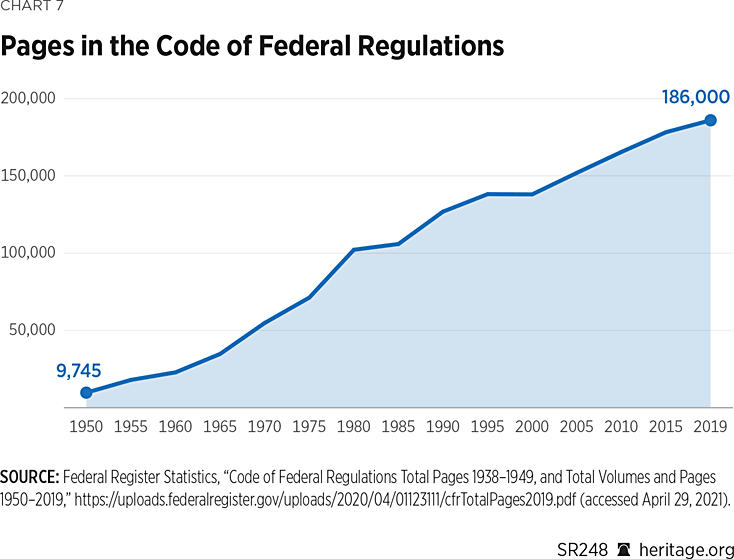
The relentless increase in regulatory burdens acts as a drag on the economy. It shifts resources from innovation, expansion, and job creation to compliance with government edicts—many of which are unnecessary, and even laughable.
For instance, the federal government has set the serving size of breath mints, and has demanded 12-point type on clothing labels. It prohibits dog walkers from strolling with more than four pooches at a time, and requires cat food manufacturers to list calories in “kilocalories per kilogram.”
The feds also restrict the amount of water per flush (for toilets and urinals) and limit electricity for the oven clock.
These examples are not anomalies in an otherwise rational regulatory system. Indeed, never before has the federal government exerted so much control over virtually every aspect of Americans’ lives, including yard sales, light bulbs, TV volume, telephone rates, toothbrushes, furniture, linen, and the size of the holes in Swiss cheese (Grade A must be 3/8 of an inch to 13/16 of an inch in diameter).
Not all mandates are unwarranted, of course. But today there are hundreds of thousands of pages of rules crafted to regulate lifestyle rather than to preserve free enterprise or protect public health and safety.
The total cost of compliance is unknown but includes direct expenses, such as the purchase of new industrial equipment, process and product re-engineering, retraining, record-keeping and administrative support, and loads and loads of legal advice. Indirect costs entail deferred investment in innovation, heightened barriers to competition, and diminished job creation.
While a burden for all, mandate overreach harms low-income families and fixed-income seniors the most; the compliance costs translate to higher consumer prices that exhaust a relatively larger share of their household budgets.
The Lowdown on UMRA
The torrent of mandates and pre-emptions has periodically provoked pushback from state and local officials. Notwithstanding public sentiment in favor of civil rights protections, public health protections, and environmental improvement, governors, legislators, and mayors protested the multitude of mandates imposed throughout the 1960s and 1970s.
Congress responded by enacting the State and Local Government Cost Estimates Act of 1981, which required the CBO to estimate the costs to state and local governments from every significant bill or resolution reported in the House or the Senate.REF
In 1981 testimony before the House Rules Committee, then-CBO Director Alice Rivlin expressed support for providing information to Congress on the costs to state and local governments of proposed federal programs. “In some cases,” she said, “the burden of federal initiatives on state and local governments is very heavy, and focusing only on federal costs can be misleading.”REF
Between 1982 and 1995, the CBO provided Congress with more than 7,000 such estimates. However, lacking procedural impediments to new mandates, the 1981 act had no apparent impact on the proliferation of obligations.REF Consequently, in 1993, critics sponsored a National Unfunded Mandates Day to highlight the issue, prompting then-Senate Majority Leader Bob Dole (R–KS) to prioritize passage of mandate relief for state and local governments. The result was enactment of the Unfunded Mandates Reform Act.
As described in the bill summary, the purpose of UMRA was “[t]o curb the practice of imposing unfunded Federal mandates on States and local governments…and to ensure that the Federal Government pays the costs incurred by those governments in complying with certain requirements under Federal statutes and regulations, and for other purposes.”REF
Title I of UMRA directs the CBO to identify mandates in select bills and joint resolutions reported by House and Senate committees, and to estimate whether the direct costs would exceed specified thresholds.REF The act also requires the CBO to identify any proposed appropriations or outlays for funding the mandate—which is considered “unfunded” unless proposed funding would cover all costs.
Title II of the act requires federal agencies (excluding independent agencies) to include analyses of mandate costs in notices of proposed rulemakings if they are likely to cost state, local, or tribal governments or the private sector $100 million or more annually in the first five years (adjusted annually for inflation).
For rules that exceed the UMRA threshold, agencies must conduct cost-benefit analyses, identify the statutory authority for the rule, and document agency rulemaking consultations with state, local, and tribal representatives.
The procedural requirements of UMRA provide Congress with useful information for considering the cost implications of proposed mandates, but they do not impose any constraint on new directives. Consequently, there is little evidence that Members of Congress have been dissuaded from proposing new mandates.
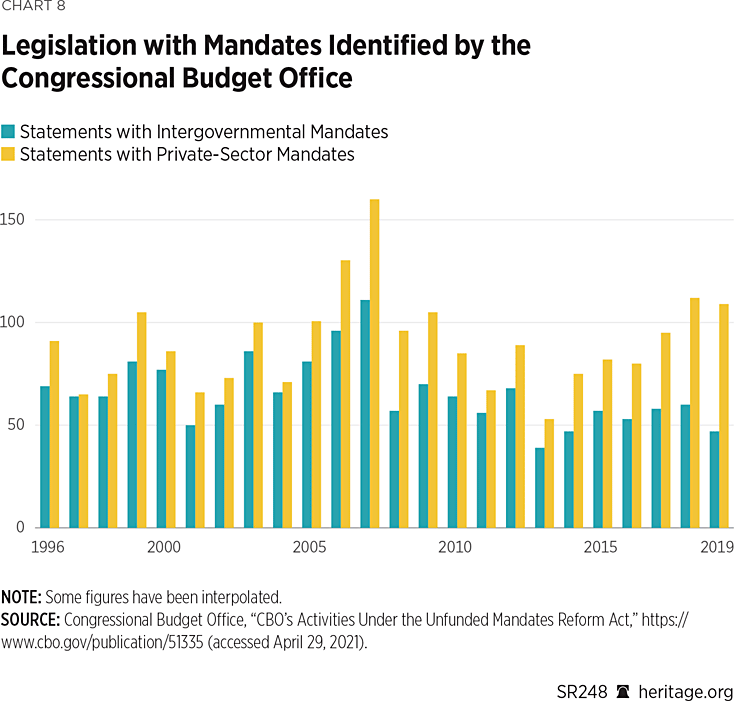
Instead, UMRA authorizes a point of order against consideration of legislation if it contains unfunded intergovernmental federal mandates exceeding $50 million, or if a committee, when reporting a bill or joint resolution, fails to include in either the committee report or the Congressional Record a statement from the CBO estimating the direct costs of any mandates contained in the legislation.REF
Well-intentioned as it was, UMRA is largely a hollow exercise because of its many exemptions and loopholes.REF It excludes statutory orders related to constitutional rights, discrimination, national security, independent agency rules, emergency assistance, rules issued without a general notice of proposed rulemaking,REF and Social Security and most types of federal assistance, as well as grant obligations and federal pre-emptions whose fiscal effects fall below the UMRA threshold. The UMRA procedural requirements do not apply to appropriations bills, floor amendments, or conference reports,REF which are prevalent tools of lawmaking in Congress.REF
The CBO estimates are also restricted to direct costs, and thus ignore the wide-ranging effects of intergovernmental and private-sector mandates across the economy. As noted by the U.S. Government Accountability Office, “[A] rule could reduce industry gross revenues by over $100 million in a single year, and therefore be economically significant, yet not trigger UMRA because it does not require expenditures above UMRA’s threshold in any year.”REF
UMRA was intended to force Members to vote specifically on imposition of a mandate to meet statutory goals, according to the late Paul Posner, a former president of the American Society for Public Administration. “As such,” he said, “it was not an impenetrable barrier, but more of a ‘speed bump’ that could promote accountability which could potentially embarrass mandate proponents and rally opponents.”REF
The Congressional Research Service has documented only limited effects from UMRA. According to a 2019 report, a total of 62 points of order were raised in the House, and four in the Senate, between 1996 and May 2019. Only one point of order—related to a 1996 minimum wage bill—was sustained in the House, and two points of order—concerning amendments to an increase in the minimum wage in 2005—were sustained in the Senate.REF
Summarizing a common sentiment about the act, Representative Tom Davis (R–VA), former Chairman of the House Committee on Government Reform, said: “[M]any have begun to express concern that UMRA is not an effective tool in preventing the imposition of unfunded mandates as a result of exclusions in coverage and various loopholes in the law that exists [sic]. The fact is, Congress would exempt itself from the laws of gravity if it could.”REF
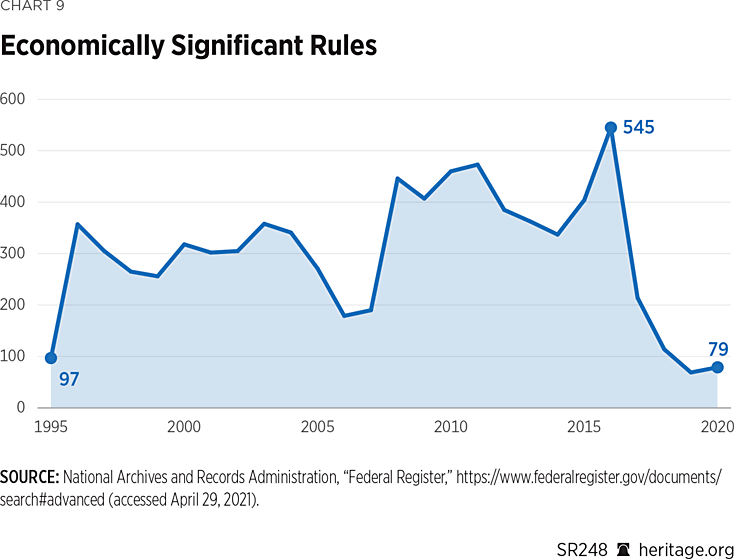
Recommendations for Government Action
All three branches of government share the blame for the collapse of federalism, and action by all three is necessary to revive it. The President’s authority to modify regulation is limited; the White House cannot countermand regulatory directives from Congress. For its part, Congress evades accountability by crafting ambiguous statutory language that fills court dockets. The lawsuits enable judges to write law rather than interpret law.
Reform need not become tangled in the hyper-partisanship that sidelines most congressional action these days. The goal is to ensure that every mandate and pre-emption is necessary, effective, and abides by constitutional apportionments of authority. To reach this goal, the U.S. government should:
Conclusion
Federal encroachment on state and local affairs, and the government’s unrestrained regulatory reach, threaten to pervert the fundamental character of the nation, its constitutional framework, and republican ideals. The challenge before the nation is to divest power from the administrative state, restore the constitutional constraints that best safeguard liberty, and make America exceptional once again.
Diane Katz is Senior Research Fellow in Regulatory Policy in the Thomas A. Roe Institute for Economic Policy Studies, of the Institute for Economic Freedom and Opportunity, at The Heritage Foundation.
Appendix: Index of Federalism
The following figures document the dramatic expansion of federal encroachment on state and local affairs, and the erosion of American federalism.
Total number of intergovernmentalREF mandates enacted:
Total number of private-sector mandates enacted:
Total number of intergovernmental mandates enacted that exceed $50 millionREF annually:
Total number of private-sector mandates enacted that exceed $100 millionREF annually:
Total number of “major rules” (annual costs exceeding $100 million) with unfunded mandates:
Total number of final regulations with “federalism” impacts:
Total number of federal grant-in-aidREF programs:
Total dollar amount of federal grants-in-aid to state and local governments:
Total number of federal information collections from state and local governments:
-
Codify President Ronald Reagan’s Executive Order 12612. President Reagan issued this orderREF “to restore the division of governmental responsibilities between the national government and the States…and to ensure that the principles of federalism established by the Framers guide the Executive departments and agencies in the formulation and implementation of policies.” The order directs departments and agencies to grant states the “maximum administrative discretion possible” and to limit state discretion “only where constitutional authority for the action is clear and certain and the national activity is necessitated by the presence of a problem of national scope.”REF
Among other things, the order instructs departments and agencies to construe a statute as pre-empting state law “only when the statute contains an express preemption provision or other firm and palpable evidence compelling the conclusion that the Congress intended preemption of State law, or when the exercise of State authority directly conflicts with the exercise of Federal authority under the Federal statute.” The new statute should include judicial review language to enable enforcement of the standards.
-
Amend the Congressional Review Act (CRA) to require agencies to conduct and report federalism assessments in rulemaking. Congress should require agencies to conduct federalism assessments (for review by the Office of Management and Budget) for all proposed rules with federalism implications. Each assessment must certify that the rule complies with federalism policymaking criteria and contains an analysis of state costs that the rule will impose. Agencies should be required to report the results of such federalism assessments to Congress.REF
-
Obligate Members of Congress to cite the clause or section of the Constitution under which their proposed legislation is justified. Legislative sponsors should be required to identify the constitutional basis of their bills. Floor time should be allotted to debate the sufficiency of the justification. These requirements would remind legislators and voters alike that the powers of the federal government are limited and enumerated under the Constitution.REF
-
Define the scope of “interstate commerce” for purposes of federal regulation. Congress has routinely exceeded its limited powers under the Constitution with help from courts that employ expansive interpretations of the Commerce Clause. Therefore, any statute designed to regulate “interstate commerce” should define the term within the context of proper constitutional limits.REF
-
Enact anti-delegation legislation that ends the unconstitutional transfer of lawmaking authority from the legislative branch to the executive branch. Congress, not regulators, should make the laws and be accountable to the American people for the results. No major regulation should be allowed to take effect unless and until Congress explicitly approves it.
-
Expand the application of UMRA. Congress should eliminate the various exemptions and loopholes in the original act, and subject all significant legislation with mandates or pre-emptions (including those issued by independent agencies) to CBO assessment and other UMRA requirements. Congress should expand the CBO cost analysis beyond the narrowly defined “direct costs” to encompass other significant effects of mandates and pre-emptions.
-
Sunset obsolete mandates and pre-emptions automatically. Congress should set sunset dates for all major mandates and pre-emptions. These should expire automatically if not explicitly reaffirmed by the relevant agency through the formal rulemaking process. As with any such regulatory decision, this reaffirmation would be subject to review by the courts.
- 190 laws with mandates (between 2006 and 2019)
- 294 laws with 790 mandates (between 2007 and 2019)
- 16 statutes with 22 mandates since 1996 (for a minimum cost of $1.47 billion annually)
- 108 statutes with 157 mandates since 1996
- 297 (between June 1995 and October 2019)
- 486 (between 1996 and 2020)
- 169 major rules (between 1996 and 2020)
- 1,274 in 2018 (compared to 664 in 1998, 387 in 1968, and 132 in 1960)
- $721 billion in 2019 (30.7 percent of total state spending)
- 351 mandatory information collections involving 1,328 forms (and 53 pending requests for an additional 169 forms)
- 979 information collections for state and local governments to obtain or retain benefits (and 95 pending requests)


